Strategic Human Resource Management Report: HealthReach, HR Components
VerifiedAdded on 2022/11/22
|12
|2874
|262
Report
AI Summary
This report, prepared for HealthReach, a large Australian healthcare provider, addresses declining employee performance and satisfaction. The analysis identifies key issues stemming from an increased reliance on casual nursing staff and proposes four critical components of a high-performance work system: organizational learning, employee training, changes to contracts and payment policies, and fostering teamwork with decision-making power. The report emphasizes the importance of organizational learning to foster innovation and autonomy, employee training to enhance skills and address soft skills gaps, revising contracts to improve job security and motivation, and empowering teams with decision-making authority. It examines the positive impact of these components on employee attitudes, performance, and overall organizational effectiveness, recommending their adoption to mitigate current problems and create a more engaged and productive workforce. The report cites relevant research and theories to support its recommendations, aiming to transform HealthReach into a high-performance organization.
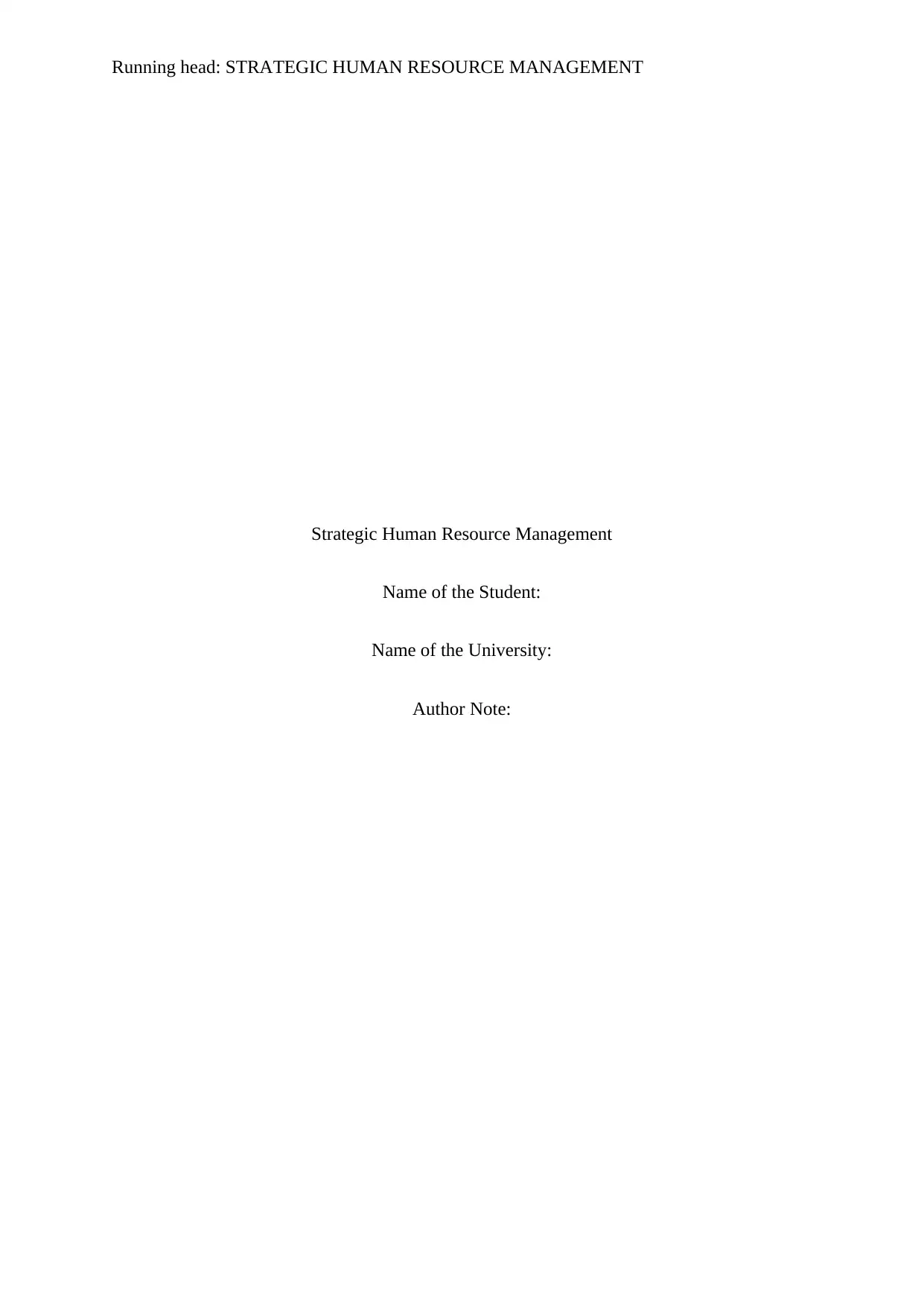
Running head: STRATEGIC HUMAN RESOURCE MANAGEMENT
Strategic Human Resource Management
Name of the Student:
Name of the University:
Author Note:
Strategic Human Resource Management
Name of the Student:
Name of the University:
Author Note:
Paraphrase This Document
Need a fresh take? Get an instant paraphrase of this document with our AI Paraphraser
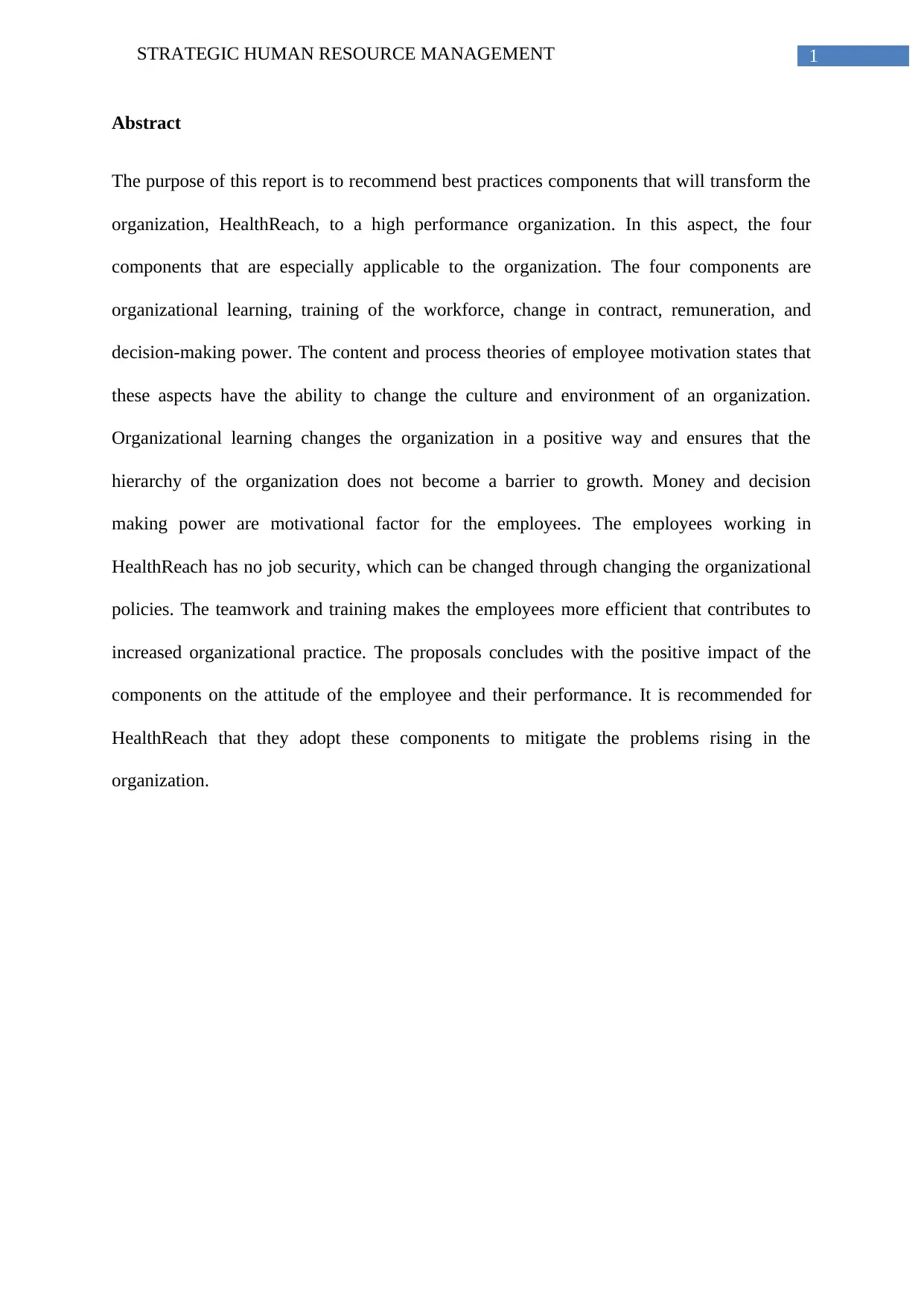
1STRATEGIC HUMAN RESOURCE MANAGEMENT
Abstract
The purpose of this report is to recommend best practices components that will transform the
organization, HealthReach, to a high performance organization. In this aspect, the four
components that are especially applicable to the organization. The four components are
organizational learning, training of the workforce, change in contract, remuneration, and
decision-making power. The content and process theories of employee motivation states that
these aspects have the ability to change the culture and environment of an organization.
Organizational learning changes the organization in a positive way and ensures that the
hierarchy of the organization does not become a barrier to growth. Money and decision
making power are motivational factor for the employees. The employees working in
HealthReach has no job security, which can be changed through changing the organizational
policies. The teamwork and training makes the employees more efficient that contributes to
increased organizational practice. The proposals concludes with the positive impact of the
components on the attitude of the employee and their performance. It is recommended for
HealthReach that they adopt these components to mitigate the problems rising in the
organization.
Abstract
The purpose of this report is to recommend best practices components that will transform the
organization, HealthReach, to a high performance organization. In this aspect, the four
components that are especially applicable to the organization. The four components are
organizational learning, training of the workforce, change in contract, remuneration, and
decision-making power. The content and process theories of employee motivation states that
these aspects have the ability to change the culture and environment of an organization.
Organizational learning changes the organization in a positive way and ensures that the
hierarchy of the organization does not become a barrier to growth. Money and decision
making power are motivational factor for the employees. The employees working in
HealthReach has no job security, which can be changed through changing the organizational
policies. The teamwork and training makes the employees more efficient that contributes to
increased organizational practice. The proposals concludes with the positive impact of the
components on the attitude of the employee and their performance. It is recommended for
HealthReach that they adopt these components to mitigate the problems rising in the
organization.
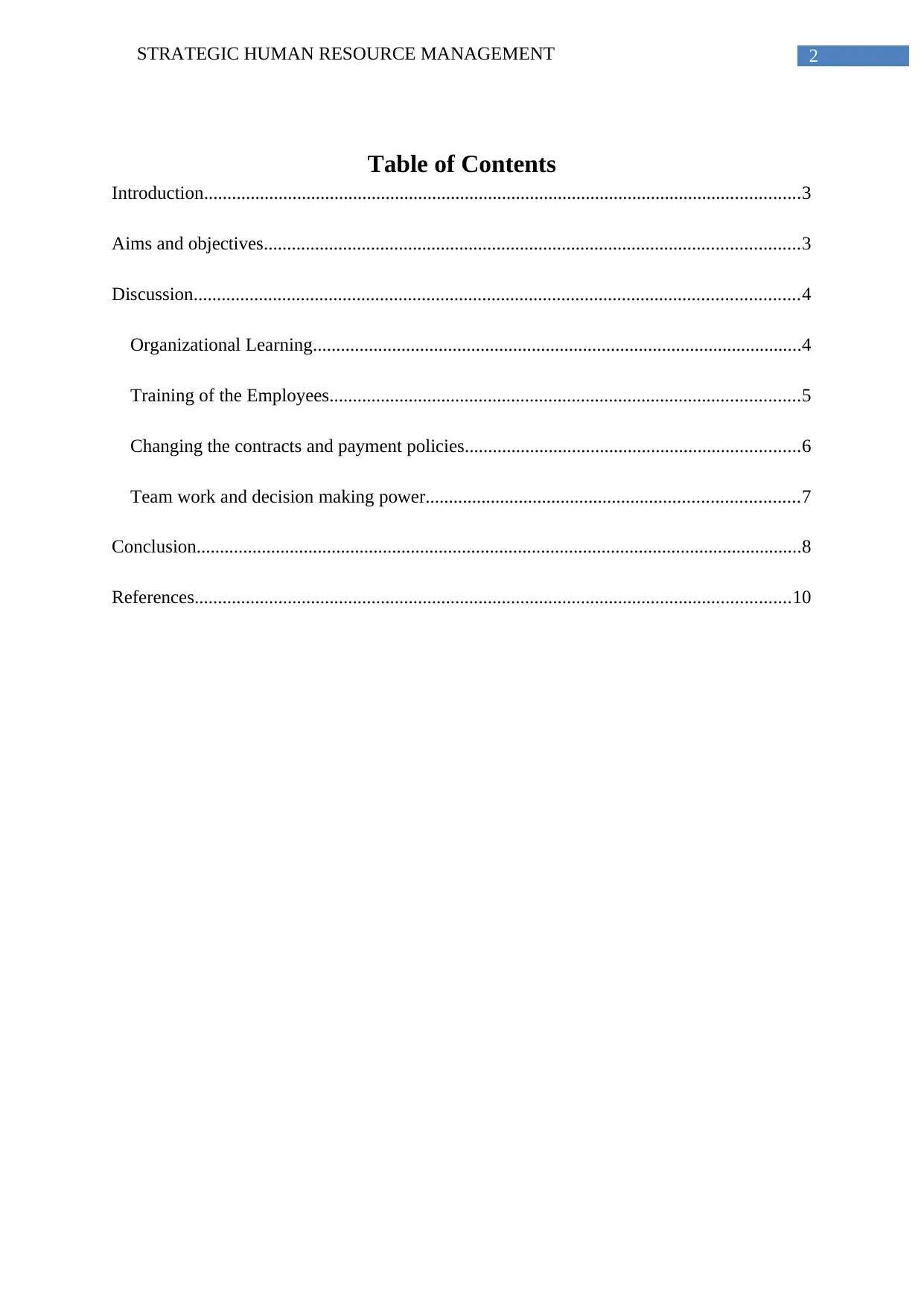
2STRATEGIC HUMAN RESOURCE MANAGEMENT
Table of Contents
Introduction................................................................................................................................3
Aims and objectives...................................................................................................................3
Discussion..................................................................................................................................4
Organizational Learning.........................................................................................................4
Training of the Employees.....................................................................................................5
Changing the contracts and payment policies........................................................................6
Team work and decision making power................................................................................7
Conclusion..................................................................................................................................8
References................................................................................................................................10
Table of Contents
Introduction................................................................................................................................3
Aims and objectives...................................................................................................................3
Discussion..................................................................................................................................4
Organizational Learning.........................................................................................................4
Training of the Employees.....................................................................................................5
Changing the contracts and payment policies........................................................................6
Team work and decision making power................................................................................7
Conclusion..................................................................................................................................8
References................................................................................................................................10
⊘ This is a preview!⊘
Do you want full access?
Subscribe today to unlock all pages.

Trusted by 1+ million students worldwide
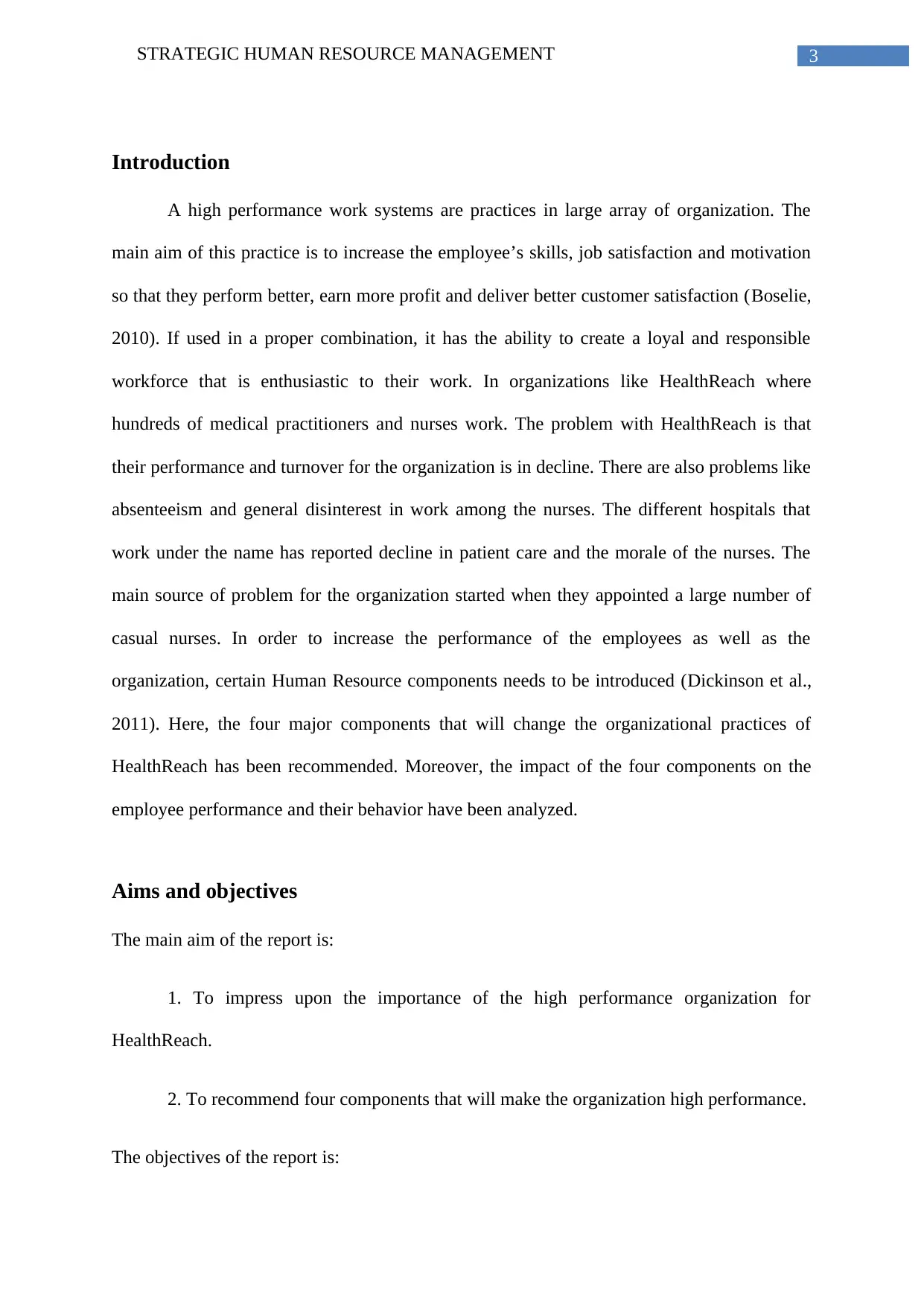
3STRATEGIC HUMAN RESOURCE MANAGEMENT
Introduction
A high performance work systems are practices in large array of organization. The
main aim of this practice is to increase the employee’s skills, job satisfaction and motivation
so that they perform better, earn more profit and deliver better customer satisfaction (Boselie,
2010). If used in a proper combination, it has the ability to create a loyal and responsible
workforce that is enthusiastic to their work. In organizations like HealthReach where
hundreds of medical practitioners and nurses work. The problem with HealthReach is that
their performance and turnover for the organization is in decline. There are also problems like
absenteeism and general disinterest in work among the nurses. The different hospitals that
work under the name has reported decline in patient care and the morale of the nurses. The
main source of problem for the organization started when they appointed a large number of
casual nurses. In order to increase the performance of the employees as well as the
organization, certain Human Resource components needs to be introduced (Dickinson et al.,
2011). Here, the four major components that will change the organizational practices of
HealthReach has been recommended. Moreover, the impact of the four components on the
employee performance and their behavior have been analyzed.
Aims and objectives
The main aim of the report is:
1. To impress upon the importance of the high performance organization for
HealthReach.
2. To recommend four components that will make the organization high performance.
The objectives of the report is:
Introduction
A high performance work systems are practices in large array of organization. The
main aim of this practice is to increase the employee’s skills, job satisfaction and motivation
so that they perform better, earn more profit and deliver better customer satisfaction (Boselie,
2010). If used in a proper combination, it has the ability to create a loyal and responsible
workforce that is enthusiastic to their work. In organizations like HealthReach where
hundreds of medical practitioners and nurses work. The problem with HealthReach is that
their performance and turnover for the organization is in decline. There are also problems like
absenteeism and general disinterest in work among the nurses. The different hospitals that
work under the name has reported decline in patient care and the morale of the nurses. The
main source of problem for the organization started when they appointed a large number of
casual nurses. In order to increase the performance of the employees as well as the
organization, certain Human Resource components needs to be introduced (Dickinson et al.,
2011). Here, the four major components that will change the organizational practices of
HealthReach has been recommended. Moreover, the impact of the four components on the
employee performance and their behavior have been analyzed.
Aims and objectives
The main aim of the report is:
1. To impress upon the importance of the high performance organization for
HealthReach.
2. To recommend four components that will make the organization high performance.
The objectives of the report is:
Paraphrase This Document
Need a fresh take? Get an instant paraphrase of this document with our AI Paraphraser

4STRATEGIC HUMAN RESOURCE MANAGEMENT
1. To evaluate the impact of the recommended components on the employee
performance.
2. To evaluate the impact of the recommended components on employee attitude of
the employees towards their job.
Discussion
The organizations like HealthReach should implement the following four components
in order to improve the organizational condition.
Organizational Learning
According to Zhu, Liu and Chen (2018), high performance of the employees in an
organization depends largely on the organizational learning. The organizational learning has
many aspects. HealthReach has practices hierarchical organizational culture, which hinders
the employee improvement. The nurses that worked in the hospitals were not supervised on
the job though they had to follow the strict guidelines laid out by the organization. They are
employed through a casual contract. They do not have job security neither they have any
freedom to work as they please. This lack of freedom to work created resentment among
them. In order to improve this condition, the organization needs to employ organizational
learning and take example from other high performance organization. They need to employ
strategies like innovativeness in their everyday routine tasks, reactiveness in communicating
and interacting with the nurses and take risks where it is necessary (Dieleman & Harnmeijer,
2016). In Apple, the employees are continuously inspired to innovate and relate their findings
to the leaders. The new findings need not always be a new product or software, it could be a
method that saves production time or cost, it could be a new method of production that might
increase the effectiveness of the products or it could be new concept or requirement all
1. To evaluate the impact of the recommended components on the employee
performance.
2. To evaluate the impact of the recommended components on employee attitude of
the employees towards their job.
Discussion
The organizations like HealthReach should implement the following four components
in order to improve the organizational condition.
Organizational Learning
According to Zhu, Liu and Chen (2018), high performance of the employees in an
organization depends largely on the organizational learning. The organizational learning has
many aspects. HealthReach has practices hierarchical organizational culture, which hinders
the employee improvement. The nurses that worked in the hospitals were not supervised on
the job though they had to follow the strict guidelines laid out by the organization. They are
employed through a casual contract. They do not have job security neither they have any
freedom to work as they please. This lack of freedom to work created resentment among
them. In order to improve this condition, the organization needs to employ organizational
learning and take example from other high performance organization. They need to employ
strategies like innovativeness in their everyday routine tasks, reactiveness in communicating
and interacting with the nurses and take risks where it is necessary (Dieleman & Harnmeijer,
2016). In Apple, the employees are continuously inspired to innovate and relate their findings
to the leaders. The new findings need not always be a new product or software, it could be a
method that saves production time or cost, it could be a new method of production that might
increase the effectiveness of the products or it could be new concept or requirement all
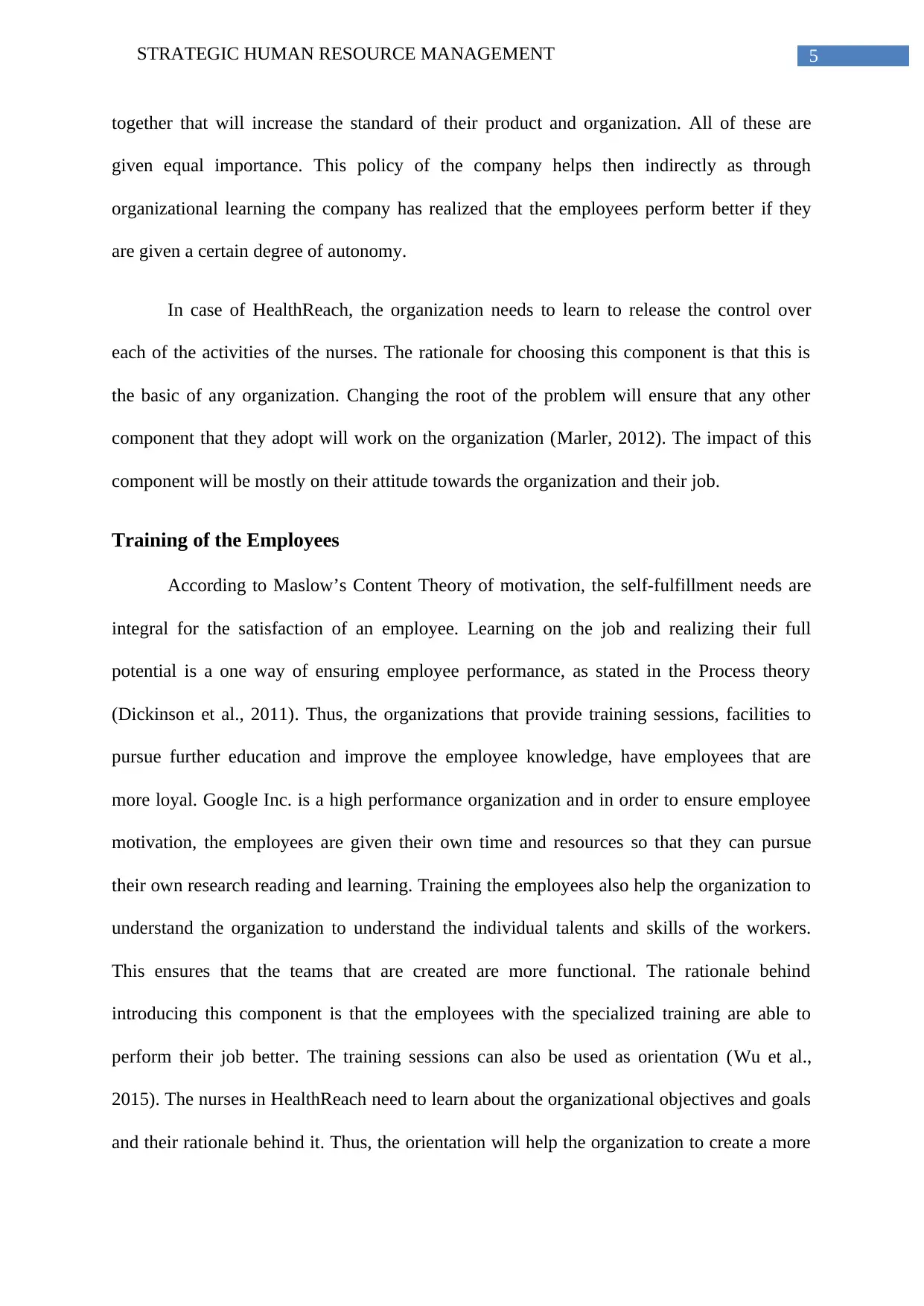
5STRATEGIC HUMAN RESOURCE MANAGEMENT
together that will increase the standard of their product and organization. All of these are
given equal importance. This policy of the company helps then indirectly as through
organizational learning the company has realized that the employees perform better if they
are given a certain degree of autonomy.
In case of HealthReach, the organization needs to learn to release the control over
each of the activities of the nurses. The rationale for choosing this component is that this is
the basic of any organization. Changing the root of the problem will ensure that any other
component that they adopt will work on the organization (Marler, 2012). The impact of this
component will be mostly on their attitude towards the organization and their job.
Training of the Employees
According to Maslow’s Content Theory of motivation, the self-fulfillment needs are
integral for the satisfaction of an employee. Learning on the job and realizing their full
potential is a one way of ensuring employee performance, as stated in the Process theory
(Dickinson et al., 2011). Thus, the organizations that provide training sessions, facilities to
pursue further education and improve the employee knowledge, have employees that are
more loyal. Google Inc. is a high performance organization and in order to ensure employee
motivation, the employees are given their own time and resources so that they can pursue
their own research reading and learning. Training the employees also help the organization to
understand the organization to understand the individual talents and skills of the workers.
This ensures that the teams that are created are more functional. The rationale behind
introducing this component is that the employees with the specialized training are able to
perform their job better. The training sessions can also be used as orientation (Wu et al.,
2015). The nurses in HealthReach need to learn about the organizational objectives and goals
and their rationale behind it. Thus, the orientation will help the organization to create a more
together that will increase the standard of their product and organization. All of these are
given equal importance. This policy of the company helps then indirectly as through
organizational learning the company has realized that the employees perform better if they
are given a certain degree of autonomy.
In case of HealthReach, the organization needs to learn to release the control over
each of the activities of the nurses. The rationale for choosing this component is that this is
the basic of any organization. Changing the root of the problem will ensure that any other
component that they adopt will work on the organization (Marler, 2012). The impact of this
component will be mostly on their attitude towards the organization and their job.
Training of the Employees
According to Maslow’s Content Theory of motivation, the self-fulfillment needs are
integral for the satisfaction of an employee. Learning on the job and realizing their full
potential is a one way of ensuring employee performance, as stated in the Process theory
(Dickinson et al., 2011). Thus, the organizations that provide training sessions, facilities to
pursue further education and improve the employee knowledge, have employees that are
more loyal. Google Inc. is a high performance organization and in order to ensure employee
motivation, the employees are given their own time and resources so that they can pursue
their own research reading and learning. Training the employees also help the organization to
understand the organization to understand the individual talents and skills of the workers.
This ensures that the teams that are created are more functional. The rationale behind
introducing this component is that the employees with the specialized training are able to
perform their job better. The training sessions can also be used as orientation (Wu et al.,
2015). The nurses in HealthReach need to learn about the organizational objectives and goals
and their rationale behind it. Thus, the orientation will help the organization to create a more
⊘ This is a preview!⊘
Do you want full access?
Subscribe today to unlock all pages.

Trusted by 1+ million students worldwide
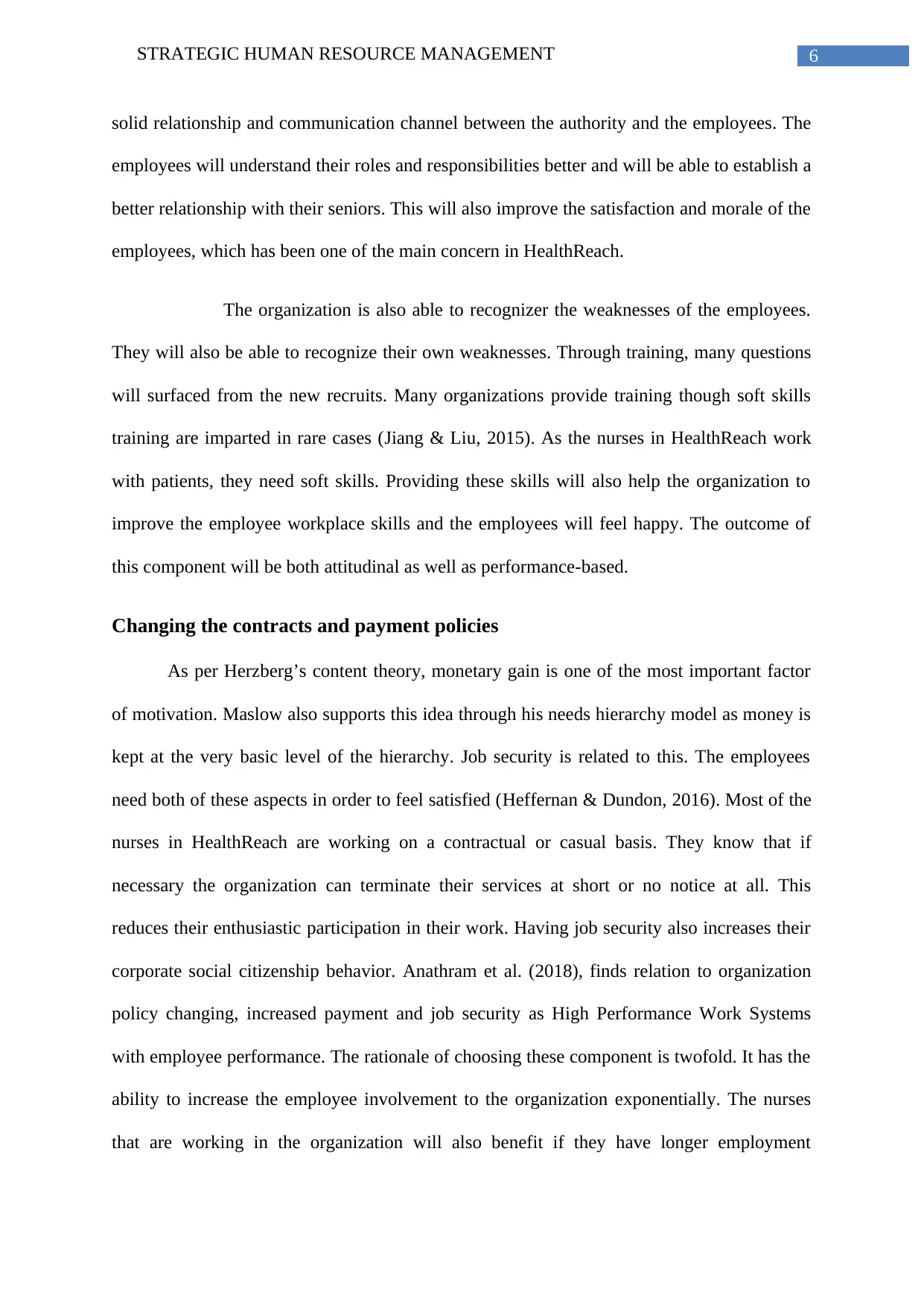
6STRATEGIC HUMAN RESOURCE MANAGEMENT
solid relationship and communication channel between the authority and the employees. The
employees will understand their roles and responsibilities better and will be able to establish a
better relationship with their seniors. This will also improve the satisfaction and morale of the
employees, which has been one of the main concern in HealthReach.
The organization is also able to recognizer the weaknesses of the employees.
They will also be able to recognize their own weaknesses. Through training, many questions
will surfaced from the new recruits. Many organizations provide training though soft skills
training are imparted in rare cases (Jiang & Liu, 2015). As the nurses in HealthReach work
with patients, they need soft skills. Providing these skills will also help the organization to
improve the employee workplace skills and the employees will feel happy. The outcome of
this component will be both attitudinal as well as performance-based.
Changing the contracts and payment policies
As per Herzberg’s content theory, monetary gain is one of the most important factor
of motivation. Maslow also supports this idea through his needs hierarchy model as money is
kept at the very basic level of the hierarchy. Job security is related to this. The employees
need both of these aspects in order to feel satisfied (Heffernan & Dundon, 2016). Most of the
nurses in HealthReach are working on a contractual or casual basis. They know that if
necessary the organization can terminate their services at short or no notice at all. This
reduces their enthusiastic participation in their work. Having job security also increases their
corporate social citizenship behavior. Anathram et al. (2018), finds relation to organization
policy changing, increased payment and job security as High Performance Work Systems
with employee performance. The rationale of choosing these component is twofold. It has the
ability to increase the employee involvement to the organization exponentially. The nurses
that are working in the organization will also benefit if they have longer employment
solid relationship and communication channel between the authority and the employees. The
employees will understand their roles and responsibilities better and will be able to establish a
better relationship with their seniors. This will also improve the satisfaction and morale of the
employees, which has been one of the main concern in HealthReach.
The organization is also able to recognizer the weaknesses of the employees.
They will also be able to recognize their own weaknesses. Through training, many questions
will surfaced from the new recruits. Many organizations provide training though soft skills
training are imparted in rare cases (Jiang & Liu, 2015). As the nurses in HealthReach work
with patients, they need soft skills. Providing these skills will also help the organization to
improve the employee workplace skills and the employees will feel happy. The outcome of
this component will be both attitudinal as well as performance-based.
Changing the contracts and payment policies
As per Herzberg’s content theory, monetary gain is one of the most important factor
of motivation. Maslow also supports this idea through his needs hierarchy model as money is
kept at the very basic level of the hierarchy. Job security is related to this. The employees
need both of these aspects in order to feel satisfied (Heffernan & Dundon, 2016). Most of the
nurses in HealthReach are working on a contractual or casual basis. They know that if
necessary the organization can terminate their services at short or no notice at all. This
reduces their enthusiastic participation in their work. Having job security also increases their
corporate social citizenship behavior. Anathram et al. (2018), finds relation to organization
policy changing, increased payment and job security as High Performance Work Systems
with employee performance. The rationale of choosing these component is twofold. It has the
ability to increase the employee involvement to the organization exponentially. The nurses
that are working in the organization will also benefit if they have longer employment
Paraphrase This Document
Need a fresh take? Get an instant paraphrase of this document with our AI Paraphraser
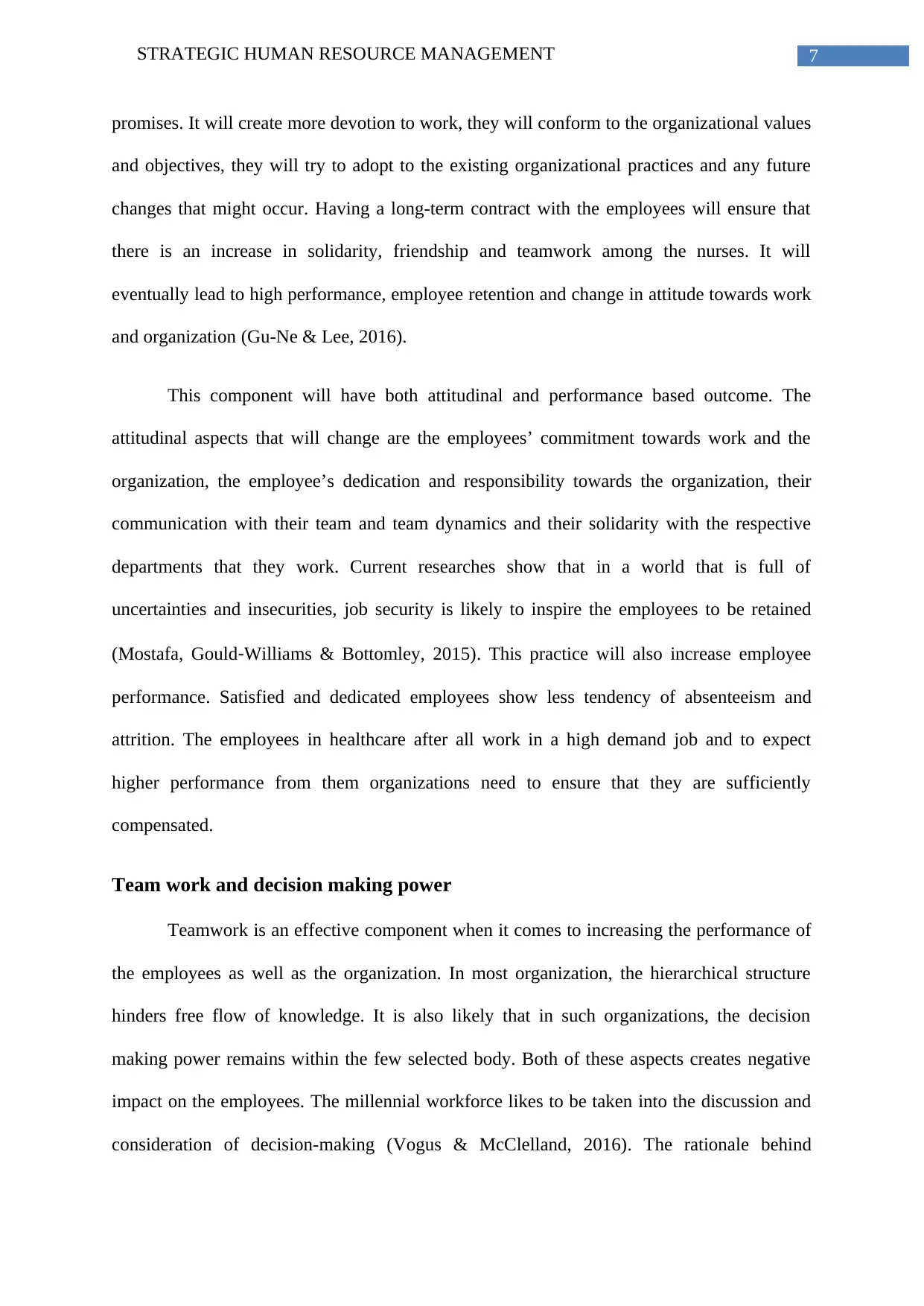
7STRATEGIC HUMAN RESOURCE MANAGEMENT
promises. It will create more devotion to work, they will conform to the organizational values
and objectives, they will try to adopt to the existing organizational practices and any future
changes that might occur. Having a long-term contract with the employees will ensure that
there is an increase in solidarity, friendship and teamwork among the nurses. It will
eventually lead to high performance, employee retention and change in attitude towards work
and organization (Gu-Ne & Lee, 2016).
This component will have both attitudinal and performance based outcome. The
attitudinal aspects that will change are the employees’ commitment towards work and the
organization, the employee’s dedication and responsibility towards the organization, their
communication with their team and team dynamics and their solidarity with the respective
departments that they work. Current researches show that in a world that is full of
uncertainties and insecurities, job security is likely to inspire the employees to be retained
(Mostafa, Gould‐Williams & Bottomley, 2015). This practice will also increase employee
performance. Satisfied and dedicated employees show less tendency of absenteeism and
attrition. The employees in healthcare after all work in a high demand job and to expect
higher performance from them organizations need to ensure that they are sufficiently
compensated.
Team work and decision making power
Teamwork is an effective component when it comes to increasing the performance of
the employees as well as the organization. In most organization, the hierarchical structure
hinders free flow of knowledge. It is also likely that in such organizations, the decision
making power remains within the few selected body. Both of these aspects creates negative
impact on the employees. The millennial workforce likes to be taken into the discussion and
consideration of decision-making (Vogus & McClelland, 2016). The rationale behind
promises. It will create more devotion to work, they will conform to the organizational values
and objectives, they will try to adopt to the existing organizational practices and any future
changes that might occur. Having a long-term contract with the employees will ensure that
there is an increase in solidarity, friendship and teamwork among the nurses. It will
eventually lead to high performance, employee retention and change in attitude towards work
and organization (Gu-Ne & Lee, 2016).
This component will have both attitudinal and performance based outcome. The
attitudinal aspects that will change are the employees’ commitment towards work and the
organization, the employee’s dedication and responsibility towards the organization, their
communication with their team and team dynamics and their solidarity with the respective
departments that they work. Current researches show that in a world that is full of
uncertainties and insecurities, job security is likely to inspire the employees to be retained
(Mostafa, Gould‐Williams & Bottomley, 2015). This practice will also increase employee
performance. Satisfied and dedicated employees show less tendency of absenteeism and
attrition. The employees in healthcare after all work in a high demand job and to expect
higher performance from them organizations need to ensure that they are sufficiently
compensated.
Team work and decision making power
Teamwork is an effective component when it comes to increasing the performance of
the employees as well as the organization. In most organization, the hierarchical structure
hinders free flow of knowledge. It is also likely that in such organizations, the decision
making power remains within the few selected body. Both of these aspects creates negative
impact on the employees. The millennial workforce likes to be taken into the discussion and
consideration of decision-making (Vogus & McClelland, 2016). The rationale behind

8STRATEGIC HUMAN RESOURCE MANAGEMENT
adopting this component is to build teams that are self-managed by the members and
occasionally supervised by the managers and give them certain decision making power so
that they are able to effectively manage the team and the work. The members of the team will
be responsible in delegating and managing the tasks. In order to be able to do that they will
need to decide which tasks should be given to whom, how the patients need to be cared for
and many such issues. The need for this can be explained through McClelland’s theory
(Waal, 2018). The employees need to feel that they have at least a minimal control over the
work that they are doing. The expected outcome of this component is both attitudinal and
performance based. The control over their own work and managing a team will give them
enough power to do their jobs effectively without having to depend on the opinion and
permission of others. With proper training that has already been proposed, training the
employees to proper teamwork and decision-making is possible. The impact on the
performance will come, as the nurses would become more skilled and independent. They will
become more responsible and take initiatives (Waal, & Heijtel, 2017).
Implementing all these aspects will transform HealthReach into an innovative and
high performance organization. With minimal change in attitude and organizational structure,
the organization can achieve best results.
Conclusion
From the above discussion, it can be concluded that the organization has the provision
to turn the situation over and create a workplace that fosters growth and creativity. Through
training and necessary skill knowledge, the employees will become more efficient. Efficient
employees are able to work better in teams and take decisions in critical situations. With
organizational learning, the organization will be able to decentralize their power structure and
adopting this component is to build teams that are self-managed by the members and
occasionally supervised by the managers and give them certain decision making power so
that they are able to effectively manage the team and the work. The members of the team will
be responsible in delegating and managing the tasks. In order to be able to do that they will
need to decide which tasks should be given to whom, how the patients need to be cared for
and many such issues. The need for this can be explained through McClelland’s theory
(Waal, 2018). The employees need to feel that they have at least a minimal control over the
work that they are doing. The expected outcome of this component is both attitudinal and
performance based. The control over their own work and managing a team will give them
enough power to do their jobs effectively without having to depend on the opinion and
permission of others. With proper training that has already been proposed, training the
employees to proper teamwork and decision-making is possible. The impact on the
performance will come, as the nurses would become more skilled and independent. They will
become more responsible and take initiatives (Waal, & Heijtel, 2017).
Implementing all these aspects will transform HealthReach into an innovative and
high performance organization. With minimal change in attitude and organizational structure,
the organization can achieve best results.
Conclusion
From the above discussion, it can be concluded that the organization has the provision
to turn the situation over and create a workplace that fosters growth and creativity. Through
training and necessary skill knowledge, the employees will become more efficient. Efficient
employees are able to work better in teams and take decisions in critical situations. With
organizational learning, the organization will be able to decentralize their power structure and
⊘ This is a preview!⊘
Do you want full access?
Subscribe today to unlock all pages.

Trusted by 1+ million students worldwide
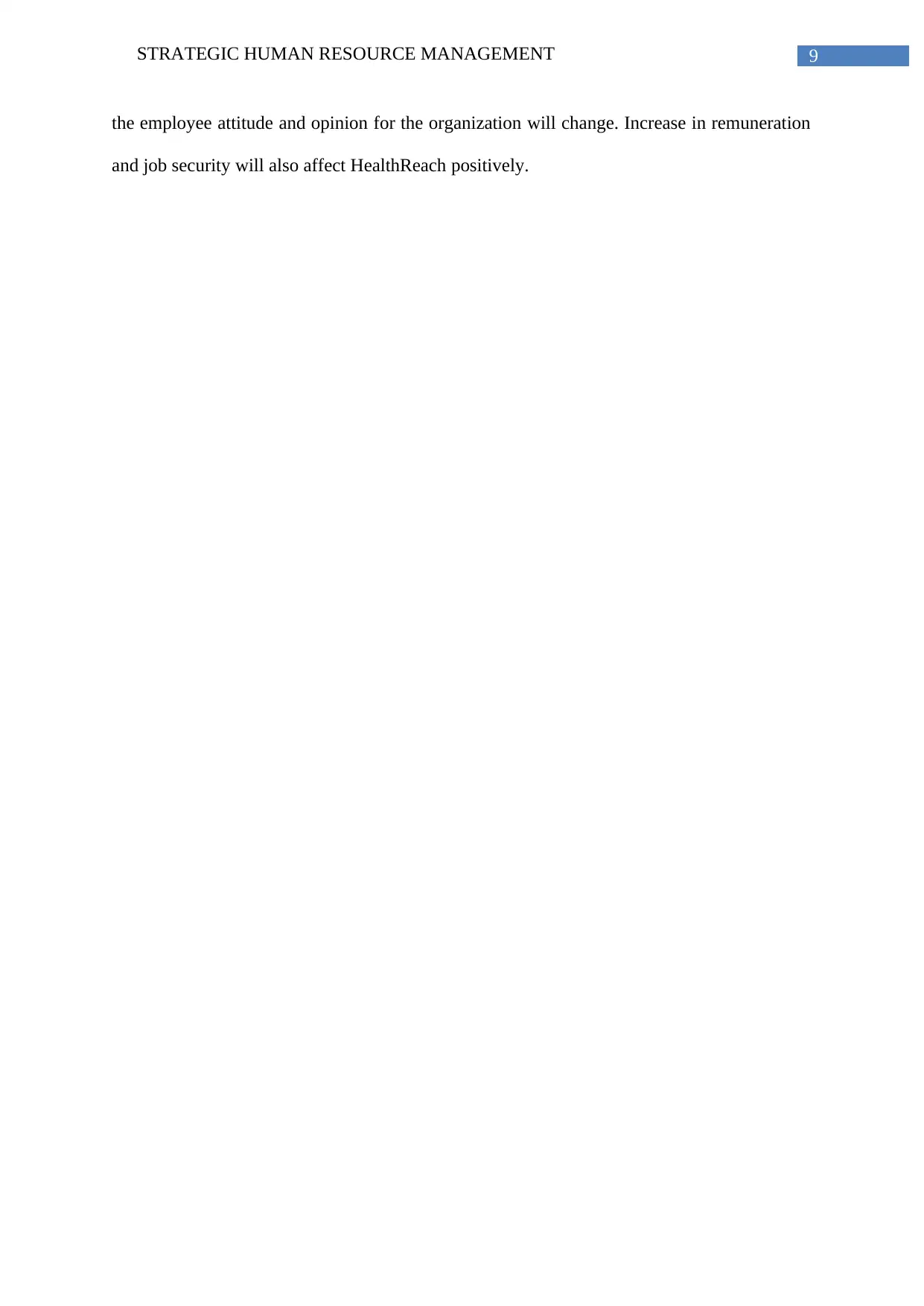
9STRATEGIC HUMAN RESOURCE MANAGEMENT
the employee attitude and opinion for the organization will change. Increase in remuneration
and job security will also affect HealthReach positively.
the employee attitude and opinion for the organization will change. Increase in remuneration
and job security will also affect HealthReach positively.
Paraphrase This Document
Need a fresh take? Get an instant paraphrase of this document with our AI Paraphraser

10STRATEGIC HUMAN RESOURCE MANAGEMENT
References
Ananthram, S., Xerri, M. J., Teo, S. T., & Connell, J. (2018). High-performance work
systems and employee outcomes in Indian call centres: a mediation
approach. Personnel Review, 47(4), 931-950.
Boselie, P. (2010). High performance work practices in the health care sector: a Dutch case
study. International Journal of Manpower, 31(1), 42-58.
de Waal, A. (2018). Success factors of high performance organization
transformations. Measuring Business Excellence, 22(4), 375-390.
de Waal, A., & Heijtel, I. (2017). Developing a change approach for the transition to a high
performance organization. Measuring Business Excellence, 21(2), 101-116.
Dickinson, H., Millar, R., West, M., Leggat, S. G., Bartram, T., & Stanton, P. (2011). High
performance work systems: the gap between policy and practice in health care
reform. Journal of health organization and management.
Dickinson, H., Millar, R., West, M., Leggat, S. G., Bartram, T., & Stanton, P. (2011). High
performance work systems: the gap between policy and practice in health care
reform. Journal of health organization and management.
Dieleman, M., &Harnmeijer, J. W. (2016).Improving health worker performance: in search of
promising practices. Geneva: World Health Organization, 5-34.
Gu-Ne, K., & Lee, Y. M. (2016). Towards high performance organization: the impacts of job
characteristics and job crafting. International Journal of u and e-Service, Science and
Tech-nology, 9(2), 85-100.
References
Ananthram, S., Xerri, M. J., Teo, S. T., & Connell, J. (2018). High-performance work
systems and employee outcomes in Indian call centres: a mediation
approach. Personnel Review, 47(4), 931-950.
Boselie, P. (2010). High performance work practices in the health care sector: a Dutch case
study. International Journal of Manpower, 31(1), 42-58.
de Waal, A. (2018). Success factors of high performance organization
transformations. Measuring Business Excellence, 22(4), 375-390.
de Waal, A., & Heijtel, I. (2017). Developing a change approach for the transition to a high
performance organization. Measuring Business Excellence, 21(2), 101-116.
Dickinson, H., Millar, R., West, M., Leggat, S. G., Bartram, T., & Stanton, P. (2011). High
performance work systems: the gap between policy and practice in health care
reform. Journal of health organization and management.
Dickinson, H., Millar, R., West, M., Leggat, S. G., Bartram, T., & Stanton, P. (2011). High
performance work systems: the gap between policy and practice in health care
reform. Journal of health organization and management.
Dieleman, M., &Harnmeijer, J. W. (2016).Improving health worker performance: in search of
promising practices. Geneva: World Health Organization, 5-34.
Gu-Ne, K., & Lee, Y. M. (2016). Towards high performance organization: the impacts of job
characteristics and job crafting. International Journal of u and e-Service, Science and
Tech-nology, 9(2), 85-100.

11STRATEGIC HUMAN RESOURCE MANAGEMENT
Heffernan, M., & Dundon, T. (2016). Cross‐level effects of high‐performance work systems
(HPWS) and employee well‐being: the mediating effect of organisational
justice. Human Resource Management Journal, 26(2), 211-231.
Jiang, J. Y., & Liu, C. W. (2015). High performance work systems and organizational
effectiveness: The mediating role of social capital. Human Resource Management
Review, 25(1), 126-137.
Marler, J. H. (2012). Strategic human resource management in context: a historical and
global perspective. Academy of Management Perspectives, 26(2), 6-11.
Mostafa, A. M. S., Gould‐Williams, J. S., & Bottomley, P. (2015). High‐performance human
resource practices and employee outcomes: The mediating role of public service
motivation. Public Administration Review, 75(5), 747-757.
Vogus, T. J., & McClelland, L. E. (2016). When the customer is the patient: Lessons from
healthcare research on patient satisfaction and service quality ratings. Human
Resource Management Review, 26(1), 37-49.
Wu, N., Hoque, K., Bacon, N., & Bou Llusar, J. C. (2015). High‐performance work systems
and workplace performance in small, medium‐sized and large firms. Human Resource
Management Journal, 25(4), 408-423.
Zhu, C., Liu, A., & Chen, G. (2018). High performance work systems and corporate
performance: the influence of entrepreneurial orientation and organizational
learning. Frontiers of Business Research in China, 12(1), 4.
Heffernan, M., & Dundon, T. (2016). Cross‐level effects of high‐performance work systems
(HPWS) and employee well‐being: the mediating effect of organisational
justice. Human Resource Management Journal, 26(2), 211-231.
Jiang, J. Y., & Liu, C. W. (2015). High performance work systems and organizational
effectiveness: The mediating role of social capital. Human Resource Management
Review, 25(1), 126-137.
Marler, J. H. (2012). Strategic human resource management in context: a historical and
global perspective. Academy of Management Perspectives, 26(2), 6-11.
Mostafa, A. M. S., Gould‐Williams, J. S., & Bottomley, P. (2015). High‐performance human
resource practices and employee outcomes: The mediating role of public service
motivation. Public Administration Review, 75(5), 747-757.
Vogus, T. J., & McClelland, L. E. (2016). When the customer is the patient: Lessons from
healthcare research on patient satisfaction and service quality ratings. Human
Resource Management Review, 26(1), 37-49.
Wu, N., Hoque, K., Bacon, N., & Bou Llusar, J. C. (2015). High‐performance work systems
and workplace performance in small, medium‐sized and large firms. Human Resource
Management Journal, 25(4), 408-423.
Zhu, C., Liu, A., & Chen, G. (2018). High performance work systems and corporate
performance: the influence of entrepreneurial orientation and organizational
learning. Frontiers of Business Research in China, 12(1), 4.
⊘ This is a preview!⊘
Do you want full access?
Subscribe today to unlock all pages.

Trusted by 1+ million students worldwide
1 out of 12
Related Documents
Your All-in-One AI-Powered Toolkit for Academic Success.
+13062052269
info@desklib.com
Available 24*7 on WhatsApp / Email
![[object Object]](/_next/static/media/star-bottom.7253800d.svg)
Unlock your academic potential
Copyright © 2020–2025 A2Z Services. All Rights Reserved. Developed and managed by ZUCOL.





